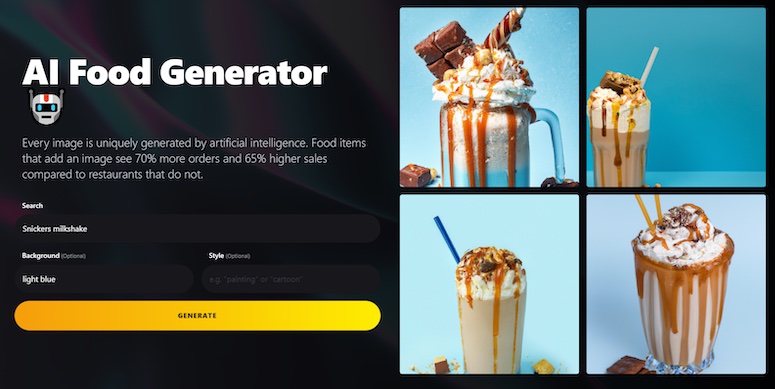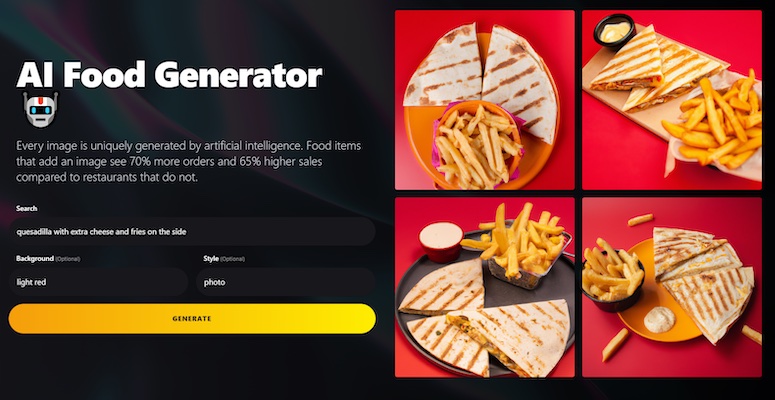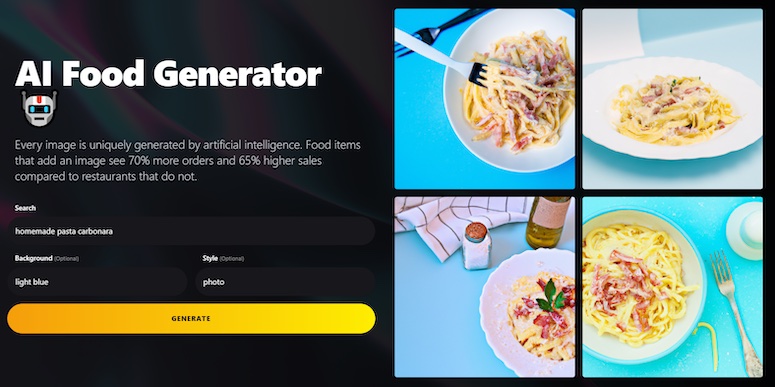If you've used text-to-image AI tools like Midjourney and DALL-E, you know that you can generate great food images with them. Use the right prompt, and the result may even look realistic.
One New York-based startup has made this process even easier by partnering with OpenAI to create an AI food generator. The startup, called Lunchbox, has released this free tool on their website.
You will notice an interesting piece of information on the Lunchbox website, noting that food items with an image see 65 percent higher sales and 70 percent more orders than those without one.
Whether this information is correct is up for debate. I noticed that Deliveroo says photography on a menu can increase orders by 24 percent. On the other, Snappr notes that high-quality photos increase orders by 35 percent based on a Google survey they commissioned. Although these numbers are smaller than what Lunchbox claims, they can still make a big difference in revenue.
How to Use the Lunchbox AI Food Generator
It's pretty easy to generate AI food images using Lunchbox. In fact, it's much easier than your average AI image generator because it has been tweaked with food in mind and you also have certain options which aren't available in other AI image generators.
Lunchbox is based on the famous DALL-E 2 text-to-image AI model developed by OpenAI. However, it's much easier to use Lunchbox than DALL-E 2 if you only want to generate food images. If you use OpenAI's model directly, you only have one field where you enter your prompt.
Lunchbox has three different fields for input. The first field is where you type in the product you want to generate. The next two fields are optional and are related to the background and the style of the image.
Here's an example of an image I generated using Lunchbox.

I have a sweet tooth, so it's natural that the first prompt I entered into Lunchbox was a Snickers milkshake. You can never go wrong with a combination of chocolate, caramel, and peanuts.
These are all great photos in my opinion. But if you were to use them to promote an item on your menu, you should make sure that it looks extremely similar to one that the Lunchbox AI produced.
After I finished looking at these AI images of milkshakes, I went to the store to pick up a Snickers bar before generating another image. This time, I wanted to give the AI a more complex prompt.

I was interested to see the results for a prompt that said "quesadilla with extra cheese and fries on the side." The results are stunning. I like the third image the most.
Are You Allowed to Use AI-Generated Images on Delivery Apps?
No, you are not allowed to use AI-generated images on delivery apps. According to an article published by Business Insider, delivery operator DoorDash noted that they don't allow photos on their app that don't correctly represent the item their users are ordering.
You are allowed to use these images on your restaurant's website and social media pages. But you should be careful about potentially misrepresenting the food items on your menu so that you don't lose customers.
But it's worth noting that when you order something at McDonald's you know that you're not really going to get what you see in the photos. As the Lunchbox CEO notes, one of their goals with this app is to give small restaurants the opportunity to have images of the same quality as the companies with the deepest pockets, like McDonald's and Domino's Pizza.
The best thing you can do is hire a professional photographer to take photos of the dishes on your menu. Still, this can be an expensive and time-consuming process. And if you don't have any images of the dishes you serve, it might lead to customers avoiding your restaurant.
That's why it's perfectly okay to have AI-generated food images of your menu as a placeholder until a photographer snaps real photos of your dishes.

Lunchbox AI is also a great tool that you can use if you want to quickly test new products to see whether they'll stick or not. If customers don't start ordering it, you can scrap the idea and try out a different product.
All in all, this generator powered by OpenAI tech is an easy way to create images that will enable your customers to imagine what the actual dish may look like. Choosing images that are as close as possible to the real thing is very important.
Finally, I have to say that Lunchbox should perhaps only be used for fast food restaurants. People who order fast food already expect that the items they order won't look exactly like the ones in the images.
Lunchbox AI - An Awesome Resource for Food Bloggers
It's natural that restaurants will dedicate a portion of their financial resources to periodically hiring highly-skilled photographers. This is an investment in their business that can increase their revenue.
On the other hand, food bloggers usually don't have the money to hire photographs. It would also be inefficient to have a photographer come in every day just to take photos of a few dishes that take you hours to prepare.
That's why I personally think that Lunchbox AI is much better for food bloggers than for restaurant owners, although it was originally developed to serve the latter group of people.
If you're into preparing a variety of dishes and want to share your recipes online but can't seem to attract visitors, you might need better images. This is where an AI-powered tool like Lunchbox can help you.

You can still use actual photos of the dish in your blogs, but the featured image can be an AI-generated one placed there to attract visitors.
If you don't have any recording equipment but want to start a YouTube channel for various recipes, you can also use this AI tool to your advantage.
You can generate multiple images for each video and put on a slideshow that people can watch while you're explaining the instructions on how to prepare the dish.
If this is the first time that you're using an AI text-to-image generator, I want to mention that you can always refine your prompts to get better results. Add more details to your prompts to create the images that you feel comfortable using.
It's worth checking out a few tutorials on how to use tools like Midjourney and DALL-E 2 to get a better understanding of how to properly utilize the power of Lunchbox AI.
Final Thoughts
Lunchbox is a New York-based startup that quickly became popular after partnering with OpenAI and releasing the world's first AI food image generator. Their initial aim was to enable even the restaurants with the smallest budgets to have high-quality images of food items on their menu.
While it's safe to use these images on your website and social media pages, you may run into problems if you try uploading them to DoorDash. This delivery app has a strict policy preventing clients from posting photos that may be misleading.
While Lunchbox released this AI tool to help restaurants, it seems that food bloggers are people who can benefit the most from it at the moment. The crave-worthy images generated by Lunchbox AI are perfect to use as featured images in food blogs to attract visitors.